AstrophotographyMethod 2 - Public displays of images at star parties.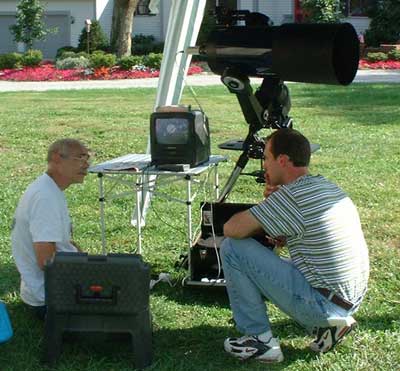 |
Great results can also be obtained with a common security camera.
The photo at left shows a camera attached to a 10-inch SCT. The cable goes into a small TV set with a built-in
vide tape recorder and player. The image of Saturn on the screen was filmed earlier and is being played back
for interested spectators. The main advantage of a CCD video camera or security camera is that you can set up
a display like this one and allow spectators to view images in real time. This photo was taken during the daytime, so
it wasn't possible to show the planets in real time, only the moon or the sun. Images of the sun reveal sunspots, but you need to use a
good solar filter over the objective end of your scope to avoid burning up the CCD chip and/or your camera. One fellow I know uses a 42-inch flat screen TV mounted in the back of his van to display images, complete with "space music". |
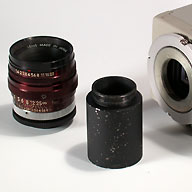 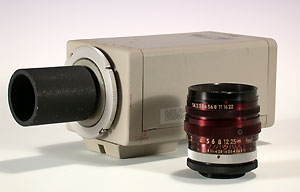 Used security cameras can be found on ebay for a few dollars. The monochrome cameras tend to be more light sensitive than the color cameras,
but either one will do a great job on the bright planets. Most of them have a "C" mount and the lens just screws into the body.
Unlike your digital camera, you need to remove the lens and replace it with a simple tube with the same threaded "C" mount.
Used security cameras can be found on ebay for a few dollars. The monochrome cameras tend to be more light sensitive than the color cameras,
but either one will do a great job on the bright planets. Most of them have a "C" mount and the lens just screws into the body.
Unlike your digital camera, you need to remove the lens and replace it with a simple tube with the same threaded "C" mount. | |
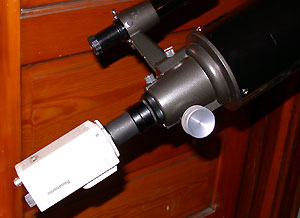 The adapter tube fits right into the barrel of your focusing tube. If you are near your home, you can run a cable to your TV or VCR and record the images that you see. You will be amazed at the results! Imaging with these cameras is limited to bright objects. Newer cameras, including the AVA StellaCam and the ITE DeepSky-Pro allow real-time viewing and recording of fainter objects, including star clusters, nebulae and many galaxies. Often, the view on your video monitor when using one of these cameras is brighter than the view seen through the eyepiece, and offers more detail. For more in-depth information on video camera astro-imaging, see http://www.lafterhall.com/stars.html. This is a great site for an introduction to video astrophotography techniques. |
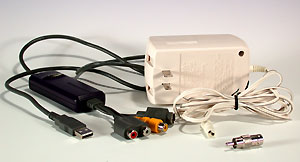 If you want to run the feed into your laptop, you need another arrangement. Most security cameras have a BNS connector. This needs to be converted to an RCA jack. Radio Shack, among other places, sells a converter, shown in the foreground of this photo (the small silver item). This allows you to plug it into your TV or VCR. Belkin makes a device which accepts an RCA jack and converts the output to a USB cable which will plug directly into your laptop. I haven't found a firewire version of this, but I'm still looking. This setup also uses the 12V power supply shown on the right in this photo. This plugs into an outlet somewhere in your home. |
 Battery powered mini-cameras are available, but the used security cameras mentioned above really can be had for a couple of dollars. Everyone is getting rid of them,
even though they work great!
Battery powered mini-cameras are available, but the used security cameras mentioned above really can be had for a couple of dollars. Everyone is getting rid of them,
even though they work great!